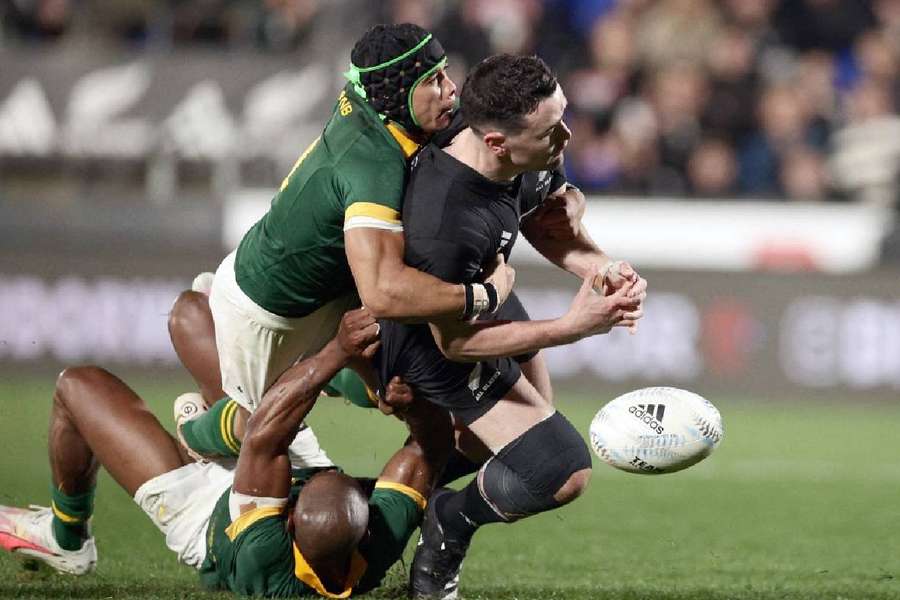For the Springboks and the All Blacks, life on the wing is as good now as ever

Cheslin Kolbe and Kurt-Lee Arendse on one side, Will Jordan and Mark Telea on the other - much is made of the expected clash of two packs of monstrous forwards, but the duel that will be played out on the wings will be elite.
Let's take a closer look at these duels because, with such lethal weapons, we hope to see a spectacle in a final, a match that is often decided by finishers and which often rewards the team who makes the fewest mistakes. There will be fireworks in all four corners of the pitch tonight.
Kolbe & Arendse - fraternal twins
"We're defending champions, but that was four years ago. To repeat that, you need a lot of sacrifice, hard work and cohesion. We want to make our country proud of us and create memories."
These were the words of Cheslin Kolbe at a press conference before the Boks took the field against Scotland. A lot of water has passed under the bridge since then, but one thing is certain - South Africa is proud.
All the more so as the spirited winger, who put the lid on the final four years ago, has found a worthy counterpart in Kurt-Lee Arendse. The latter has only been in the national team for a year, but since then he has not stopped proving why. Although they might be confused by their relatively small stature and helmets, there are differences.
Kolbe is better under high balls and has a high-quality of footwork that sometimes earns him a place at full-back (he made an unforgettable 50-metre drop-goal for Toulouse in the 2021 Top 14 final).
Arendse, on the other hand, is more explosive and finds his way into tight spaces, reminiscent of Kolbe in his early days, but he has an acute sense of positioning, as well as being solid on his feet. It's a case of birds of a feather, and it's worth remembering that it was the two Boks wingers who scored the two tries in the 2019 final.
Jordan & Telea - terrifying talents
Given the number of world-class wingers New Zealand has produced, it's hardly surprising to find two highly-rated wingers in the starting line-up. But it is also their pragmatism that makes them stand out.
"Winning the World Cup is what we all came here for, so I'll be perfectly happy not to be on the scoresheet if it means we get the job done".
These were the words of Will Jordan after the semi-final win over Argentina. Of course, we can smile, because aside from an injury, there was no chance of him not being in the starting line-up. More than a try a game on average for the new emblem of Kiwi realism, ruthless on the run, sovereign under the high ball. A machine on the way to becoming a legend.
But given the choice, the New Zealand staff opted to add a new face to the team in Mark Telea. Another of last year's revelations, he earned his place in the opening match against France, scoring two splendid tries at the start of each half, but also showing in each match the fire he had in his legs to constantly move forward in tight spaces. A quality he will probably have to exploit this Saturday.
Incredible depth on the wing
It's quite astonishing to field four quality wingers when you consider who is missing. On the South African side, in addition to the promising Canan Moodie, who is hardly used due to competition and a bench that has turned towards the forwards, the other holder of the position in the 2019 final, Makazole Mapimpi, fractured his cheekbone during the competition. This no doubt spared the coach a painful choice.
Ian Foster had to make the same choice, resigning himself to leaving out future Toulon player Leicester Fainga'anuku for this final, as the latter was not even on the bench. Even though he had shone in the quarter-finals, scoring the first try to create a gap after which the Irish chased the whole game. And when you consider that Caleb Clarke has not been used and Sevu Reece is not even there, it is a chilling amount of depth on the wing.
The weight of history
There are countless talented wingers that these two nations have produced. When you think of the All Blacks, you think of course of Jonah Lomu, the legend, never a world champion, but unforgettable and the first name that springs to mind when you think of a New Zealand winger. Far ahead of Doug Howlett, record try-scorer for the Silver Ferns, or Joe Rokocoko and Julian Savea, incredible finishers, not to mention John Kirwan.
On the South African side, Bryan Habana immediately springs to mind, but then again, that side has always been brimming with talent. It's impossible not to think of Breyton Paulse, JP Pietersen, James Small and Pieter Rossouw. The older players will say Pieter Hendriks, executor of an anthologised step on a certain David Campese during the 1995 World Cup.
In nine World Cup finals, we have seen 16 tries, seven of them scored by wingers - John Kirwan, Ben Tune, Lote Tuiqiri, Jason Robinson, Nehe Milner-Skudder, Makazole Mapimpi and Cheslin Kolbe.
Further proof of the importance of this position, especially in modern rugby. It promises to be a splendid battle between the wingers, and we'll be keeping an eye on all four corners of the pitch to make sure we don't miss out on any of the action.
